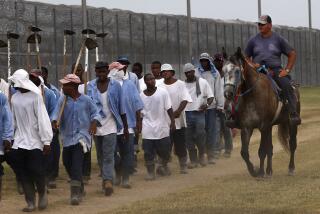Leader to Seek Agriculture Dept. Help : U.S. Team Tours Drought-Stricken Dixie
- Share via
About 330 starving cows stunned a federal delegation inspecting damage from the South’s severe drought Monday by stampeding after a pickup truck dumping hay in a parched south Alabama pasture.
“It’s the most dramatic thing I’ve seen,” said Assistant U.S. Secretary of Agriculture George Dunlop, who heads the seven-member team touring farms in four states to seek ways to aid the stricken farmers.
“We’re going to try to get the help of the Department of Agriculture,” Dunlop said. “This drought is not the last.”
First Stop on Tour
“I hope it’s the last one for me,” said V. C. Martin, 73-year-old owner of the 1,200-acre ranch south of Montgomery that was the first stop on the two-day tour. “God knows, I can’t go on much longer.”
The record heat continued Tuesday. Temperatures in much of the Southeast ranged from the upper 90s to a record 106 degrees in Macon, Ga.
Showers and thunderstorms were scattered across the region, with more numerous thunderstorms from coastal North Carolina across eastern parts of South Carolina and Georgia.
Storm-driven winds damaged two houses at Helena, Ga., and small hail and 40-m.p.h. winds swept Goose Creek, S.C. Hail half an inch in diameter was reported near Lillington, N.C.
Temperatures were expected to remain hot throughout the Southeast, with readings mainly in the 90s today, forecasters said. Scattered thundershowers were forecast, with only isolated areas expected to receive significant rainfall.
The federal agriculture delegation visited the 600-acre cattle and poultry operation of Bill and Wesley Chandler in Ila, Ga., Monday afternoon and was scheduled to inspect the farms of H. Todd Arant of Bowman, S.C., and Bill Dorsett of Elfland, N.C., today before returning to Washington.
$1 Billion in Damage
Officials conservatively report that damage to crops, livestock and poultry from the century’s worst drought in the region totals more than $1 billion.
Kneeling in Martin’s pasture, Dunlop tried in vain to jab a finger into the hard, cracked earth.
“It looks green, but there’s not any depth to it,” Dunlop said. “There’s no moisture. I’ve seen first-hand the damage that this has created.”
Martin told the group that he has not had any rain of consequence since March 19 and has been forced to keep his gaunt cows alive by feeding them grain and hay usually reserved for the winter.
He started the year with 400 head of cattle, but he has been forced to sell about 70 head because of the drought.
Meanwhile, donations and pledges of hay came from farmers across the Farm Belt. In Indiana, farmers loaded 15 tons of South Carolina-bound hay aboard trucks.
Wisconsin farmers offered to donate about 15,000 bales of hay, and plans for an emergency airlift were being made, with Gov. Anthony Earl asking the White House to approve the use of reserve transport planes.
Another shipment of nearly 900 bales of donated Illinois hay was flown to South Carolina on Monday to help farmers feed their starving animals.
Appeal by Governor
Responding to an appeal from South Carolina Gov. Dick Riley, western Illinois farmers took hay to the Quad-City Airport in Moline, Ill., where the bales were loaded aboard an Air Force transport plane and flown to South Carolina.
Illinois officials said they hope to have a collection location established by Thursday to ship two, 80-car trainloads of hay to Georgia and South Carolina.
Cattlemen in Missouri, enjoying a banner year, are planning to ship at least 60 bales to Georgia in boxcars for distribution to farmers.
And Iowa Gov. Terry Branstead said he is checking to see if National Guard planes can be used to fly hay donated by his state’s farmers.
More to Read
Sign up for Essential California
The most important California stories and recommendations in your inbox every morning.
You may occasionally receive promotional content from the Los Angeles Times.













